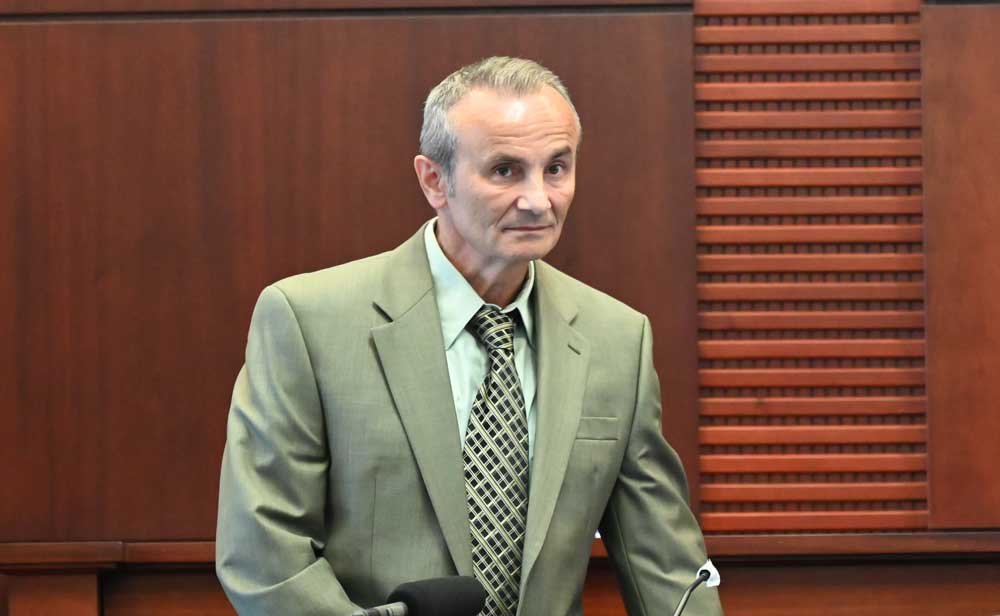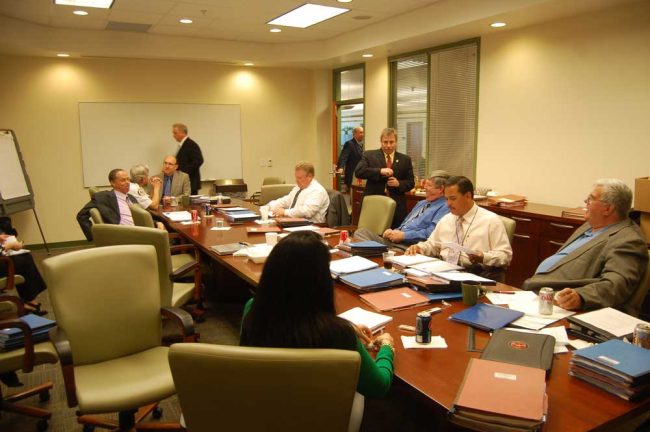
Dr. Predrag Bulic, the chief medical examiner for Flagler, St. Johns and Putnam counties–a position as low profile as it is critical to the justice system and families in the determination of the cause of death of thousands of individuals each year–died unexpectedly over the weekend of a severe stroke he suffered last week, after serving almost 12 years in that position. he was 63.
Bulic, like most medical examiners, was not a household name, but his influence could be immense in deciding how the State Attorney’s Office would handle homicides, overdoses or even vehicle crash deaths. The medical examiner’s cause-of-death an d manner-of-death determination defines whether that death is charged as a crime or not, and often at what level of crime it should be charged, the trajectory of a fatal bullet or knife wound on a body potentially marking the difference between first or second-degree murder, or manslaughter–or suicide.
The position is highly political, as evidenced by the formal process that leads to a medical examiner’s appointment. It involves elaborate , public interviews by a panel that includes the state attorney, the public defender, sheriffs and police chiefs, and other elected representatives from the given district. Flagler is part of District 23. It also involves a rigorous between-the-lines analysis of potential candidates’ dispositions, as prosecutors want someone who will help them make cases–someone not overly inclined to give reasonable doubt its due. (On the interview panel, public defenders are outnumbered from the get-go.)
St. Johns county, which administers the St. Augustine-based office of the Medical Examiner, today appointed Dr. Jon Thogmartin as the interim medical examiner. The position will be advertised, applications taken and interviews conducted over the next weeks or months, and the appointment will be recommended to the governor, who then ratifies the local panel’s decision.
“It was a shock to everybody,” State Attorney R.J. Lariozza, who had been among those resolving to appoint Bulic in January 2011, said today of Bulic’s death. “From what I’m told he had a stroke. It looked like it was pretty bad, then they said, look we don’t think he’s going to pull through.”
Bulic, Larizza said, had been physically active, had been a runner and would take care of himself, which added to the surprise of his death. “He did an excellent job. And he was young, I’d like to say young, heck I’m older than he is,” Larizza said.

“He was easy to work with, he was friendly,” Larizza said, underscoring the importance of the job. “The most obvious is the medical examiner, he or she, performs autopsies in homicide cases or murder cases and provides that information to the criminal justice system so we can determine whether or not it was an actual crime or not, testifies at the trial if there is a trial, regarding the allegations versus a plea, they also do autopsies for suicides, they do them for overdoses, and they do a lot of autopsies that aren’t criminal in nature, it could be a malpractice issue with a medical facility or a medical doctor, it could be a family that wants to know what happened to their loved one.” Much of the work isn’t crime-related but civil in nature.
Bulic had taken over a medical examiner’s office that had been somewhat in disarray under its predecessor, Terrence Steiner, got it accredited by the National Association of Medical Examiners, and built up its staff of now 12 full-timers, from seven just three years ago. “He left that office much better than the way he found it,” Larizza said of Bulic.
Flagler, St. Johns and Putnam are party to a tri-party agreement that originally set Bulic’s salary at $200,000. It is now well over that, and the next medical examiner will see his or her salary rise significantly, Larizza said.
“Consensus was that was not an attractive salary in today’s dollars, and I think you’ll see a pretty significant increase,” Larizza said. “It’s up to the counties to do that, but if you look at other ME salaries, there’ll probably be an increase and potentially a significant one.”
The Medical Examiner’s office has a current budget of $1.34 million. St. Johns county share is $757,000, with Putnam and Flagler contribute $872,000 (Flagler’s share is 24 percent, Putnam’s 30 percent.) In 2021, the last full year tallied, the office conducted 560 autopsies for the three counties and approved 4,100 cremations for a total of 4,660 cases. It’s estimating 5,600 cases this year.
Every time Bulic would appear in court–usually in murder trials, as a witness for the prosecution–an assistant state attorney would have to establish his credentials before the jury. So he would provide what amounted to a mini-biography.
He was an emergency-room physician in Yugoslavia for five years before that nation’s break-up in 1991. He went to the United States in 1988 as a graduate student in molecular biology, eventually shifting to pathology. He had residency training in Jackson, Miss., for five years, then did two fellowships in forensic pathology and surgical pathology in Fort Lauderdale. He was on call in the Medical Examiner’s office there when he was called out to the Seminole Hard Rock Hotel and Casino in Hollywood to begin the investigation of the death of Anna Nicole Smith, the celebrity who died of an overdose. The same year–2007–he took a job in the Medical Examiner’s office in Volusia County, rising to assistant ME there under Dr. Marie Herrmann (she retired in 2018), before applying for the Chief Medical Examiner’s job in District 23 in 2011.
“Dr. Bulic,” Assistant State Attorney Jason Lewis asked him at the beginning of his testimony in a trial last September, “how many autopsies have you conducted in your career?”
“About 4,000,” Bulic said. Lewis asked him how many times he’d testified in trials. “Somewhere around between 200 and 300 times,” Bulic said. He spoke with a heavy Balkan accent, but not so heavy that jurors ever had trouble understanding him. He deadpanned his delivery, slowly, humorlessly but with obsessive precision, at times telling the prosecutor he would be more effective stepping down from the witness stand to guide the jury through his points with images flashed on an oversized television screen, and a pointer in his hand.

He would typically described his job in clinical detail: “Autopsy is a surgical procedure that is performed by pathologists, and it serves to find out why somebody dies. So there are several steps, and they’re always been in this order. So first, the body is being brought to the medical examiner’s office. And then we open the body bag where the body is being transported in. Then we photograph the body as is, as it was on the scene and then put in the body bag. Then we take the body out of the body bag and we inspect the body carefully, and collect the evidence from, whether it’s the fingernails or from the pubic area, depending on if we find any type of materials that we deem that is necessary to be collected.
“And then also we take the DNA on a paper card as well as we photograph the entire body from head to toe. Then we wash the body so that we can see extent of the injuries, because sometimes the body is covered or caked with blood. And of course, that comes after we undress, if there are any clothes, we undress the body and remove the clothes, and then wash the body, then photograph everything again from head to toe. And that’s considered external examination. And then the second part of the autopsy is internal incarnation, where we basically cut the body. We eviscerate all the organs, take the organs out of the body cavities and examine everything, including the brain, the neck area, the chest and abdomen area and the extremities, in order to find out the extent of injuries or extent of the disease.”
It isn’t yet clear when the interviews for the next appointment will take place. “We have a very qualified interim medical examiner in Dr. Martin,” Larizza said, “but the county would like to fill the position without too much of a lapse. But I think they want to make sure–we all do–that we get the most qualified and best suited individual, so there’ll be a process or posting or recruiting and interviewing and vetting.”





























Clu Wright says
While Bulic did 4000 autopsies he never did the autopsy of Michelle O’Connell and still everyone if those in a position believed his nonsense of cause of death. Michelle O’Connell did not jill herself and if anyone wants to challenge me on the facts let’s go. Not on this page but a live you tube video. Since the St Johns
County Sheriff’s Office, State Attorney and the Medical Examiners Office did not release the facts, I WILL.
Geezer says
I recall seeing an expose / documentary about this some years back.
I remember Dr. Bulic’s bullshit forensic demonstration.
It is outrageous—it stinks to high heaven.
This guy was a major player in a criminal conspiracy.
Death does not absolve Bulic!
Geezer says
Watch Citizen PI on Discovery Plus, Season 1, Episode 1, which looks at Michelle O’Connor’s
suspicious “suicide.”
Amy Megginson says
Same situation. My daughter was an abused wife and was murdered as we were packing her and her 4 kids to leave. I was there and watched as she died while they argued. The corruption in this county was disgusting. No wonder they have the highest incidents in ALL of Florida of suicide in that tiny county.
John says
Oddly When I was an Army Officer I met many guys from overseas that had M.D.s but the US does not recognize most degrees out of Country. I have met Russians locally that state their degrees are not accredited or accepted. Now this guy is from Yugoslavia? There are plenty of doctors in the US with experience in forensics, pathophysiology, micro, etc. Most skilled General Surgeons could do the job. But that salary far exceeds $500k. You get what you pay for. Who knows maybe doc Mcstuffins from Yugoslavia was ok.